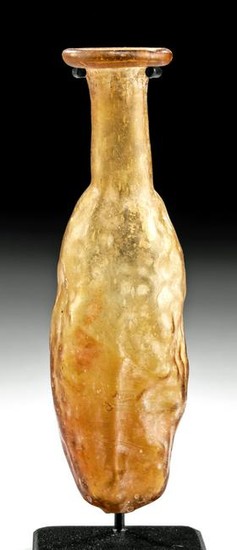Gorgeous Roman Glass Date Flask Mold-Blown
Roman Empire, Lebanon, Sidonian, ca. mid 1st to early 2nd century CE. A fine mold-blown flask resembling a date fruit in gorgeous amber glass with hues that ranges from deep caramel to light champagne - its generally oblong form rising to a cylindrical neck and a flared, folded rim. Note how the mold was carefully crafted to create the impression of a date's wrinkled skin. In addition to its stunning coloring, traces of silvery iridescence cast a glow upon the surface. Size: 3.875" H (9.8 cm); 4.375" H (11.1 cm) on included custom stand.
Here are Pliny's words as he describes his voyage to Sidon, "From this point on we must go back to the coast and to Phoenicia. There was formerly a town called Crocodilian, and there still is a river of that name…Then comes Cape Carmel …Next are Getta, Geba, and the river Pacida or Belus …Close to this river is Ptolemais …Next Tyre, once an island separated from the mainland by a very deep sea-channel 700 yards wide, but now joined to it by the works constructed by Alexander when besieging the place …but the entire renown of Tyre now consists in a shell-fish and a purple dye! …Next are Zarephath and the city of birds (Ornithon oppidum), and Sidon, the mother-city of Thebes in Boeotia where glass is made." (Pliny, Natural History V.75-76, 77-79 CE).
A Roman glass date flask sold for $2500 at Christie's Sale 15792, Antiquities, New York, 18 April 2018.
For further reading and comparable examples, see no. V-57, Reflection on Ancient Glass from the Borowski Collection. Also see, Toledo, Roman Mold Blown Glass, nos. 84 - 107. The author notes that Phoenicia during the 1st century CE "was famous not only for mold blown glass but for its date palms," and this may have "inspired glass workers in Phoenicia to blow vessels shaped like dates."
Provenance: ex-private New Jersey, USA collection, handed down from owner's parents. Acquired 1980's to 1990
All items legal to buy/sell under U.S. Statute covering cultural patrimony Code 2600, CHAPTER 14, and are guaranteed to be as described or your money back.
A Certificate of Authenticity will accompany all winning bids.
We ship worldwide to most countries and handle all shipping in-house for your convenience.
#149299
Condition Report: Internal bubbles, minor nick to base, and areas of weathering film; otherwise simply superb.
View it on
Estimate
Time, Location
Auction House
Roman Empire, Lebanon, Sidonian, ca. mid 1st to early 2nd century CE. A fine mold-blown flask resembling a date fruit in gorgeous amber glass with hues that ranges from deep caramel to light champagne - its generally oblong form rising to a cylindrical neck and a flared, folded rim. Note how the mold was carefully crafted to create the impression of a date's wrinkled skin. In addition to its stunning coloring, traces of silvery iridescence cast a glow upon the surface. Size: 3.875" H (9.8 cm); 4.375" H (11.1 cm) on included custom stand.
Here are Pliny's words as he describes his voyage to Sidon, "From this point on we must go back to the coast and to Phoenicia. There was formerly a town called Crocodilian, and there still is a river of that name…Then comes Cape Carmel …Next are Getta, Geba, and the river Pacida or Belus …Close to this river is Ptolemais …Next Tyre, once an island separated from the mainland by a very deep sea-channel 700 yards wide, but now joined to it by the works constructed by Alexander when besieging the place …but the entire renown of Tyre now consists in a shell-fish and a purple dye! …Next are Zarephath and the city of birds (Ornithon oppidum), and Sidon, the mother-city of Thebes in Boeotia where glass is made." (Pliny, Natural History V.75-76, 77-79 CE).
A Roman glass date flask sold for $2500 at Christie's Sale 15792, Antiquities, New York, 18 April 2018.
For further reading and comparable examples, see no. V-57, Reflection on Ancient Glass from the Borowski Collection. Also see, Toledo, Roman Mold Blown Glass, nos. 84 - 107. The author notes that Phoenicia during the 1st century CE "was famous not only for mold blown glass but for its date palms," and this may have "inspired glass workers in Phoenicia to blow vessels shaped like dates."
Provenance: ex-private New Jersey, USA collection, handed down from owner's parents. Acquired 1980's to 1990
All items legal to buy/sell under U.S. Statute covering cultural patrimony Code 2600, CHAPTER 14, and are guaranteed to be as described or your money back.
A Certificate of Authenticity will accompany all winning bids.
We ship worldwide to most countries and handle all shipping in-house for your convenience.
#149299
Condition Report: Internal bubbles, minor nick to base, and areas of weathering film; otherwise simply superb.



